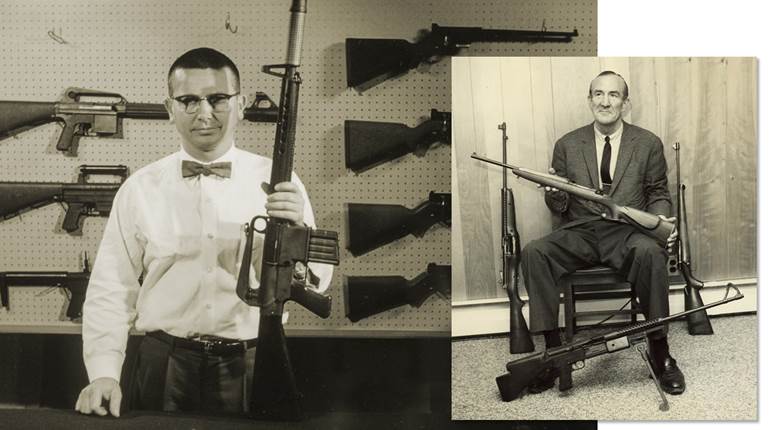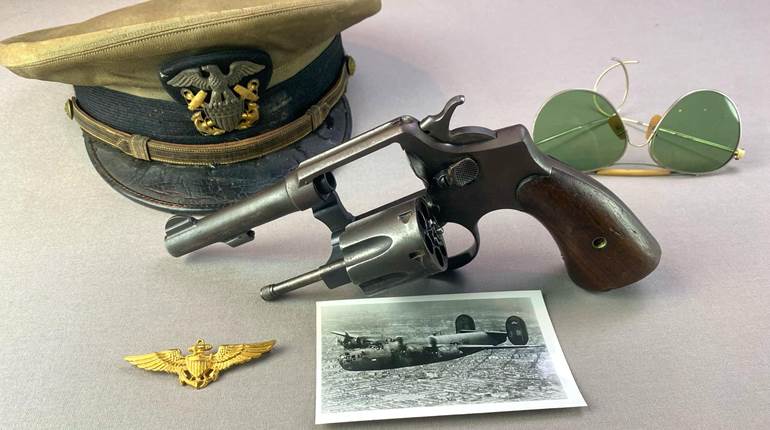
Most of today's arms enthusiasts and collectors are familiar with the service rifles used by the United States military over the past two centuries. Such arms as the .45-70 Gov't "Trapdoor" Springfield, .30-40 Krag-Jorgensen, Model 1903 Springfield, M1 Garand, M14 and M16 are well known and have been the subjects of numerous books and articles. Part of the reason for the familiarity is because our armed forces used most for a rather lengthy time period. For example, the U.S. military used the M1903 Springfield to one extent or another for more than 40 years. Likewise, the M16 (and variants) has also been in use for more than four decades and is still going strong. In addition to being in service for years, many of these rifles were manufactured and, in some cases such as the M1 and M16, produced well into the millions. On the other hand, there were some service rifles produced in very limited numbers and were only utilized by our armed forces for a brief period of time.
One of the least known, but quite interesting, rifles of this type is the Remington-Keene U.S. Navy rifle. The rifle was the invention of New Jersey arms designer John W. Keene. Keene had been working on his bolt-action repeating rifle since the early 1870s and eventually received nine separate patents pertaining to the design. The rifle's turning bolt operated in more or less the typical fashion. The action was unlocked by raising the bolt upward, and the empty case was extracted and ejected by pulling the bolt to the rear. As the bolt was almost fully retracted, the "magazine elevator" (as it was called by the inventor) raised a fresh cartridge from the tubular magazine into position in the breech so it could be chambered when the bolt was pushed forward. Manipulation of the bolt also automatically cocked the cocking piece, which was fashioned in the shape of an external hammer. It could be lowered to "half cock" to function as a safety. The "hammer" was one of the more recognizable components of the design and was viewed as a safety feature, as soldiers unfamiliar with repeating bolt-action rifles of the era sometimes had trouble ascertaining if a rifle was cocked. With the Keene rifle's external hammer-shaped cocking piece, one could easily observe its position to determine if the rifle was fully cocked and ready to fire.
The rifle's tubular magazine was under the barrel and was encased in-and protected by-the stock's fore-end. The location of the magazine required that the cleaning rod be offset to the left side of the fore-end. As with most of the other bolt-action military repeating rifles of the time, the Keene was fitted with a magazine cut-off to permit it to function as a single-shot, with the contents of the magazine held in reserve for "emergency" use.
Keene's rifle came to the attention of the Remington Arms Co. as the firm was seeking a bolt-action repeater that might be acceptable to an Ordnance Department "Magazine Gun Board" that was convened in 1878. An agreement was reached for the company to fabricate several prototype Keene rifles for submission to the Board. Remington had previously devoted most of its efforts and capital to its popular line of "rolling block" rifles, and it did not have a satisfactory bolt-action repeating design to compete with the Winchester lever-action and other repeating arms in the Ordnance Department testing. Although the "Remington-Keene," as it came to be known, was rejected by the 1878 Ordnance Board in favor of the bolt-action Hotchkiss, the rifle performed well enough to justify the faith that Remington had in the design. The company subsequently produced the Remington-Keene in several configurations for the civilian market, including carbine and sporting rifle variants.
Remington desired military contracts and-since the Army wasn't interested in the rifle-overtures were forthcoming to the U.S. Naval Bureau of Ordnance for consideration of Remington-Keene. The U.S. Navy closely monitored the Army's 1878 Magazine Gun Board, so it was familiar with the rifles. Shortly after the Army Board's selection of the Hotchkiss, the Navy began procurement of some 2,500 Hotchkiss rifles as well. Despite its decision to purchase a significant quantity of the Hotchkiss arms, the Navy also elected to acquire a relatively small number of two other bolt-action, magazine-fed repeating rifles for evaluation and limited issue. One was a design of James P. Lee that featured a detachable box magazine-the other was the Remington-Keene. The Hotchkiss rifle's tubular magazine was located in the buttstock. There was some concern at the time regarding the safety of tubular magazines since the cartridges were in contact with each other while in the magazine. It was feared that this arrangement might have a propensity to cause accidental discharges of cartridges in the magazine should the rifle be jarred and the tip of a bullet strike the primer of the cartridge in front of it. By obtaining examples of all three rifles, the Navy could evaluate the relative merits of each gun's magazine system. As events transpired, the Navy determined that any problem with cartridges with lead roundnose bullets in tubular magazines causing accidental discharges was more perceived than real.
In early 1880, the U.S. Navy ordered 250 Remington-Keene "Navy" rifles. This variant weighed approximately 9 lbs. and was about 48" in length with a 29¼" barrel secured by two bands. The magazine held nine .45-70-405 cartridges. The rear sight was a folding leaf adjustable for elevation, and it was reportedly the same sight used by Remington on the "rolling block" rifles during this period. Likewise, the bayonet used with the Remington-Keene U.S. Navy was the same triangular blade socket bayonet Remington made for its military-pattern rolling blocks. This bayonet was not interchangeable with the standard Model 1873 Trapdoor Springfield bayonet. Other components, including much of the furniture (barrel bands, etc.), were the same as made for the rolling blocks as well. Remington's use of existing parts was logical, especially given the small size of the Navy contract. Remington-Keene Navy rifles were shipped from the Remington factory to the Navy for inspection prior to issue. Lt. William W. Kimball was the officer in charge of inspecting the Remington-Keenes, and on April 16, 1880, he reported to Commodore William N. Jeffers, chief of the Bureau of Ordnance, that the first 150 rifles had been inspected and were ready for issue. The remaining 100 rifles followed shortly thereafter. There are some references to the Remington-Keene Navy rifle as the "Model of 1880," presumably due to the year it was procured by the Navy. This designation, however, doesn't appear in any period documents pertaining to this subject and likely wasn't the "official" designation. The Remington-Keene Navy rifles had a "U.S." and anchor marking stamped on the left side of the barrel with a "P" (proof) and "W.W.K." (William W. Kimball) marking stamped on the right side. There were no inspection or proofmarks applied to the stock.
In an 1880 Secretary of the Navy's Report, Commodore Jeffers made the following references to the Remington-Keene and other magazine rifles: "The Hotchkiss repeating rifle has also been introduced, and these together with the Remington-Keene and the Lee guns, are considered sufficient for all experimental purposes in settling the relative value of the several (magazine) systems ... (the Hotchkiss along with) the 250 Remington-Keene and 300 Lee guns are sufficient to arm all the ships in commission with repeating rifles and to test the relative value of the three systems, viz magazines in the butt, beneath the barrel, and detachable." In addition to the 250 Remington-Keene Navy rifles, in July 1880 the government purchased 600 Remington-Keene "Frontier Model" 24"-barreled carbines. Their origin is a bit uncertain, as some sources state that these carbines were originally ordered by the Navy but were abandoned in favor of the Remington-Keene rifle.
This scenario is rather unlikely and is not supported by any known authoritative documentation. Records show these guns were shipped from the Remington factory to the U.S. Interior Department between July and August 1880 at a per unit cost of $17.50 and were purchased to arm the "Indian Police" at a number of reservations in the American West. In 1881, the U.S. Army convened yet another "Trials Board" to evaluate magazine rifles. Remington submitted two Remington-Keene "Frontier Rifles" (with eight-round magazine capacities), one with a magazine cut-off and one without.
Although the Remington-Keene reportedly fared relatively well in the tests, it was not selected by the Board for further consideration.
In addition to the .45-70, Remington produced the Remington-Keene for the commercial market in several other chamberings, including .43 Spanish and .60-40. The firm eventually sold an estimated 5,000 Remington-Keene rifles and carbines but, not counting the "Indian Police" carbines sold to the Department of the Interior, the only Remington-Keenes used by the U.S. military were the 250 Navy rifles it acquired in 1880.
These rifles were issued to ships in the Navy's fleet concurrent with the Hotchkiss and Lee bolt-action magazine rifles. Compared with its contemporary, the Hotchkiss Navy rifle, there is little in the documentary record regarding the Remington-Keene Navy rifles. The main reason for this is only 1/10th as many Remington-Keenes were obtained by the Navy compared with the total of Hotchkiss Navy rifles.
There were at least two U.S. Navy warships that had Remington-Keene rifles in their arms lockers: the U.S.S. Michigan and U.S.S. Trenton. It is clear from the few reports on record that the Remington-Keene was less popular with the Navy than either the Hotchkiss or Lee rifles. A report submitted in October 1888 regarding the Remington-Keene rifles aboard the U.S.S. Michigan cited numerous faults with the rifles, including the position of the lower sling swivel, its weight and the "... poor rear sight." The lack of interchangeability between the bayonets for the Remington-Keene and the other rifles (Hotchkiss and Lee) was also a cause for complaint. Despite these criticisms, the Remington-Keene Navy rifles remained in service with the U.S. Navy for at least eight years. Reports indicate that Remington-Keene rifles were in use on the U.S.S. Trenton at least as late as 1887 and, as cited above, the rifles remained on board the U.S.S. Michigan until at least late 1888. Records show spare parts were being procured and sent to the New York Navy Yard in 1886. Navy records also reflect that 210 slings for the Remington-Keene Navy rifles were sent to the New York Navy Yard on May 24, 1887. The Remington-Keene rifles were completely withdrawn from Navy service just before the turn of the 20th Century. The subsequent disposition of these rifles is also unknown, but they were likely sold as surplus on the civilian market. Of all the U.S. military bolt-action magazine repeating rifles of the era, the Remington-Keene Navy rifle is undoubtedly among the rarest examples of the genre today. The commercial-production Remington-Keene arms are fairly rare, but they are seen with more frequency than the U.S. Navy rifle variant. Generally speaking, other than the Navy rifle, the only Remington-Keene arm that seems to be of more than a passing interest to most collectors is the "Indian Police carbine." However, since this carbine wasn't issued as a military arm, it would normally be of little interest to many U.S. martial arms collectors.
Only 250 were manufactured, and most were subjected to the rigors of service aboard Navy warships for the better part of a decade; therefore, there aren't many extant specimens of Remington-Keene U.S. Navy rifles. The rifle is noteworthy in the evolution of the U.S. military bolt-action rifle as it was the only rifle the U.S. military contracted during this period that had an under-barrel tubular magazine. It proved to be a rather unremarkable design with few outstanding features, but it also had no fatal flaws and compared favorably to most of the other contemporary bolt-action rifles fielded by the U.S. Army and U.S. Navy during the late 1870s and 1880s.
There are few U.S. military arms of this era that are as uncommon as a genuine unaltered Remington-Keene U.S. Navy rifle and it surely remains one of the least-known U.S. military arms of the late 19th century.



















![Auto[47]](/media/121jogez/auto-47.jpg?anchor=center&mode=crop&width=770&height=430&rnd=134090788010670000&quality=60)
![Auto[47]](/media/121jogez/auto-47.jpg?anchor=center&mode=crop&width=150&height=150&rnd=134090788010670000&quality=60)
















